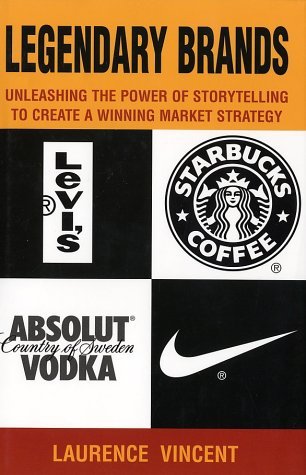Legendary Brands Summary
5 min read ⌚
 Unleashing the Power of Storytelling to Create a Winning Marketing Strategy
Unleashing the Power of Storytelling to Create a Winning Marketing Strategy
We live in a world of possibilities. Customers have an endless choice of services and products.
Who Should Read “Legendary Brands”? And Why?
In this paper, author Laurence Vincent shares his theory about legendary brands and what creates them. Vincent draws a link between advertising and storytelling and lists the elements that make a message powerful.
Those factors, he finds, are the same as the ones used in traditional storytelling forms such as films and novels. Vincent then moves on to introducing the fundamentals of myths and legends and their differences, as well as how mythical and legendary narratives can influence a brand.
He studies these concepts through real-life cases and explains how companies can use them in creating their brand marketing strategies. We recommend “Legendary Brands” to marketing and brand managers who want to try to create legends out of their existing brands.
About Laurence Vincent
 Laurence Vincent holds a Bachelor’s degree from the School of Cinema and Television, and a Master’s degree from the Marshall School of Business, both at the University of Southern California.
Laurence Vincent holds a Bachelor’s degree from the School of Cinema and Television, and a Master’s degree from the Marshall School of Business, both at the University of Southern California.
He was the CSO of Cabana Group, a marketing agency that specializes in marketing alliances between entertainment properties and leading consumer brands. He previously managed global corporate partnerships for The Walt Disney Company and developed strategies for a handful of the world’s legendary brands.
Among his clients were Coca-Cola, CBS, Four Seasons Hotels, The Home Depot, the National Football League, Microsoft, Qualcomm, MasterCard, McAfee, Southwest Airlines, Sony PlayStation. He currently supervises The Brand Studio at United Talent Agency.
“Legendary Brands Summary”
Whatever need they have, can be satisfied by an amazingly vast number of brands. Two branches consist this infinite list of labels. The first group of brands is enormous. Most of the brands, including the most familiar names, are part of this group.
They gain loyalty based on habits, price, quality and other determinants. The second group is smaller than the first one. The brands that belong to this group are more than just products – they create an emotional attachment to their customers.
This second type of brands, go beyond merely being the product they are, and they achieve becoming legendary.
Now, you ask: what is the formula for creating legendary brands? Well, for starters, promotion plays a significant part, even though it is not the only variable to the “formula.” Contrary to what you may think, the budget and its size are not vital factors.
Neither are product quality, durability, the value of the stock or geographical placement. To reach the status of a legendary brand the product needs to have the “x” factor. It needs to represent values that are important to the buyers and create an emotional bond.
Legendary brands are a modern-day marvel, created by changes in the modern society. In spite of the fact that stories have existed since the beginning of life, lately, they have become a potent influential force in shaping our human experience.
Especially advertising. The strengthening of individuality and consumer importance has incited the development of advertising content into story-driven messages. Mass entertainment and technological advancements put the even bigger accent on storytelling.
Accordingly, storytelling is the already mentioned “x” factor that separates legendary brands from the not-so-legendary ones.
Throughout history, two kinds of stories have been responsible for assigning a mythical status to places, objects or people: myths and legends. These two types of narrative are different at their cores.
Legends are created around rumors. Hence they vary depending on the circumstances and storytellers. When it comes to consumer goods, legends can have a disastrous effect on brands, since it is quite easy to get the negative brand image.
Myths, on the other hand, have eternal, lasting qualities and empower people to make sense of their realities. Shared beliefs and values create them.
We are all wired for stories. They are an inseparable part of our identities and our realities. They help us organize the chaos of information into a structure that makes sense. They shape our worldview and our experiences. In other words, understanding the concept of legendary brands basically, comes to down to understanding story.
Having said all that, it is important to note that not all brands need to be legendary. Many of them don’t have what it takes, and that is okay.
Customers can pick a brand for many other reasons, and not only because of personal beliefs and values. Becoming legendary is not the only road to success. But, if you see the potential, try to develop it.
Key Lessons from “Legendary Brands”
1. Characteristics of brands and brand mythology
2. Steps to becoming legendary
3. The dark side
Characteristics of brands and brand mythology
Some components are standard for all legendary brands. They use symbols to create emotional bondage. They feel right and simulate pleasant feelings. They are exciting and unforgettable. They present vicarious human experiences through their narratives. But the factor that is crucial for taking a brand to the legendary level is brand mythology. Brand mythology consists of four fundamental parts:
-
- Sacred beliefs, which mold the worldview of people, and are responsible for creating bondage.
-
- Brand agent, or the physical manifestation of the sacred belief. Brand agents can be people or objects.
-
- Brand narrative, or the story that the brand tells, which later on becomes the basis of all promotional campaigns
- Brand culture, or a representation of the behavioral elements of the brand, which define it through consumption
Steps to becoming legendary
- Communicate with your audience
- Find out the reception of your brand and reconsider your marketing plan from a storytelling angle
- Create a brand bible, which will help you write the perfect brand narrative. Use the four storytelling elements character, theme, plot, and aesthetics. Your story should consist of three acts: a situation, a complication, and a resolution.
- Set objectives. Before the execution itself, think of what emotions you want to awake in your customers (emotional purpose), as well as what you want them to do (behavioral intention)
- Decide on the platform through which you want to send your message (product placement, simple advertisement, etc.)
The Dark Side
You did all the above steps, and you created your brand. But what happens when your brand faces some hard times? There are three steps towards brand salvation:
-
- Go beyond fixing the cause
-
- Pick the proper brand and brand agent
- Leave the past in the past and put your attention to change
Like this summary? We’d Like to invite you to download our free 12 min app, for more amazing summaries and audiobooks.
“Legendary Brands” Quotes
The brand in crisis is the greatest challenge for the marketer. Share on X Brand partnerships are at their best when they offer tangible benefits to all participants. Share on X Legendary brands are sustained by constant conversations with the consumer. Share on X While strong consumer brands have been around for generations, legendary brands are a particularly new phenomenon. Share on X To be effective, legendary brands must observe the audience response to the stories they tell and learn how the narrative affected the audience. Share on XEmir is the Head of Marketing at 12min. In his spare time, he loves to meditate and play soccer.


 Unleashing the Power of Storytelling to Create a Winning Marketing Strategy
Unleashing the Power of Storytelling to Create a Winning Marketing Strategy




